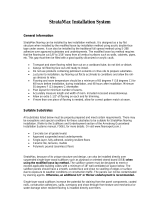
Chapter IV — Installation Systems824.
• Allow all flooring materials and adhesives to condition to the room
temperature for a minimum of 48 hours before starting the installation.
• The area to receive the resilient flooring should be maintained at a minimum
of 65°F (18°C) and a maximum of 100°F (38°C) for 48 hours before, during
and for 48 hours after completion.
• During the service life of the floor, the temperature should never rise above
100°F (38°C) nor fall below 55°F (13°C). The performance of the flooring
material and adhesives can be adversely affected outside this temperature
range.
• For concrete substrates, conduct moisture testing (moisture vapor emission
rate [MVER]) and/or percent relative humidity (in-situ probe). Bond tests
must also be conducted for compatibility with the substrate. Please refer to
Chapter III, Subfloors and Underlayments.
• Radiant heated substrates must not exceed a maximum surface temperature
of 85°F (29°C).
• Concrete floors should be tested for alkalinity. The allowable readings for
the installation of Armstrong flooring are 5 to 9 on the pH scale.
Precautions:
• Tiles are to be heated from the back only, never the face.
• Do not wash tile for at least 4 days after installation. This will allow the tile
to become well seated in the adhesive and prevent excess moisture and
cleaning agents from interfering with the adhesive bond.
• Products installed using the Tile-On System may have less resistance
to indentation. We strongly recommended the use of Armstrong Floor
Protectors.
• Install one quarter of the room at a time for all 12" x 12" (30.5 cm x 30.5 cm)
tiles.
Fitting:
See Chapter VI, Layout and Fitting for room layout. Before installing the
material, plan the layout so tile joints fall at least 6" (15.2 cm) away from
subfloor/underlayment joints. Do not install over expansion joints.
When installing over an existing resilient floor, plan the layout so the new
joints are a minimum of 6" (15.2 cm) away from the original seams. When
installing over tile floors, joints should fall in the center of the tile.
When installing 12" x 12" (30.5 cm x 30.5 cm) tiles, avoid having border pieces
less than 6" (15.2 cm) wide.
Abutting Different Gauges of Resilient Flooring: When installing thinner
gauge material next to thicker gauge materials, install thicker material first
and then butt a 12" (30.5 cm) wide piece of S-153 Scribing Felt against the
thicker material. Adhere the Scribing Felt to the subfloor with S-235 Adhesive.
Use the fine notching of the S-891 Trowel over nonporous substrates such as
existing resilient flooring, and use the regular notching of the S-891 Trowel
over porous subfloors such as wood and concrete. Use S-184 Fast-Setting
Cement-Based Patch and Skim Coat or S-194 Patch, Underlayment and
Embossing Leveler to feather the edge of the S-153 Scribing Felt to the level of



